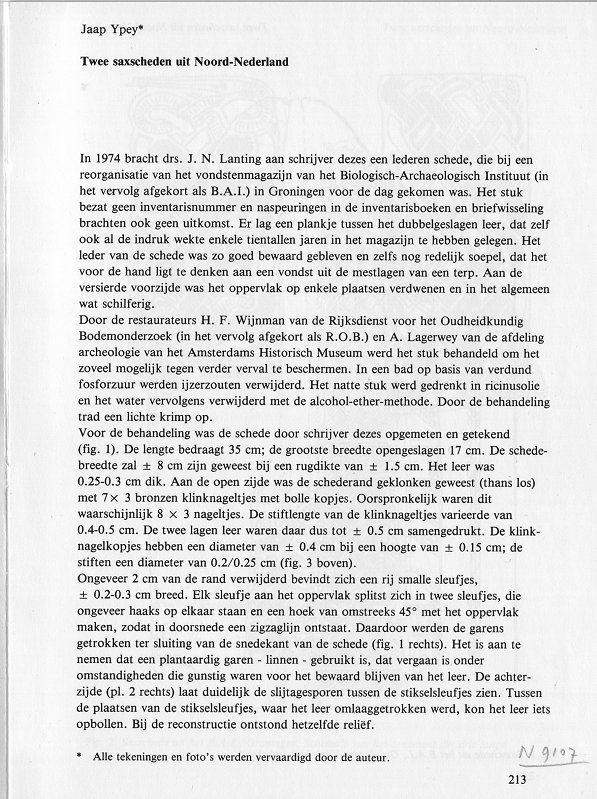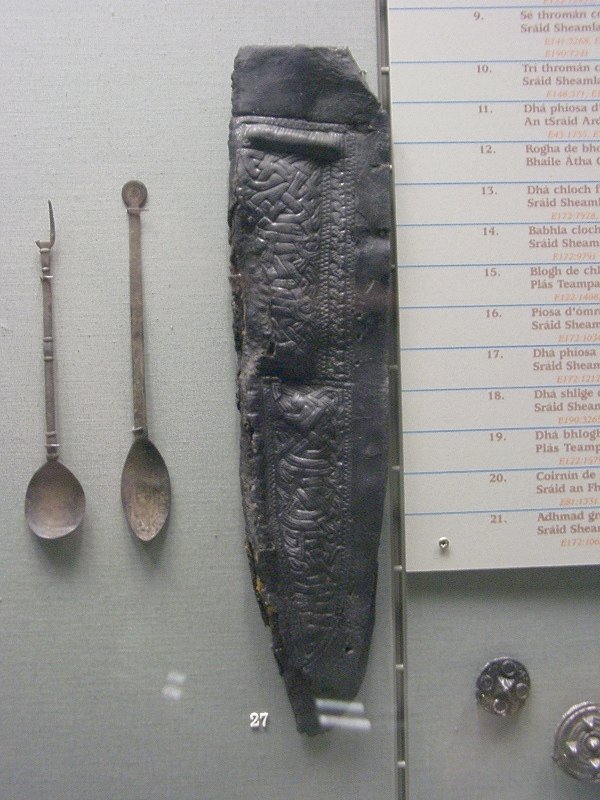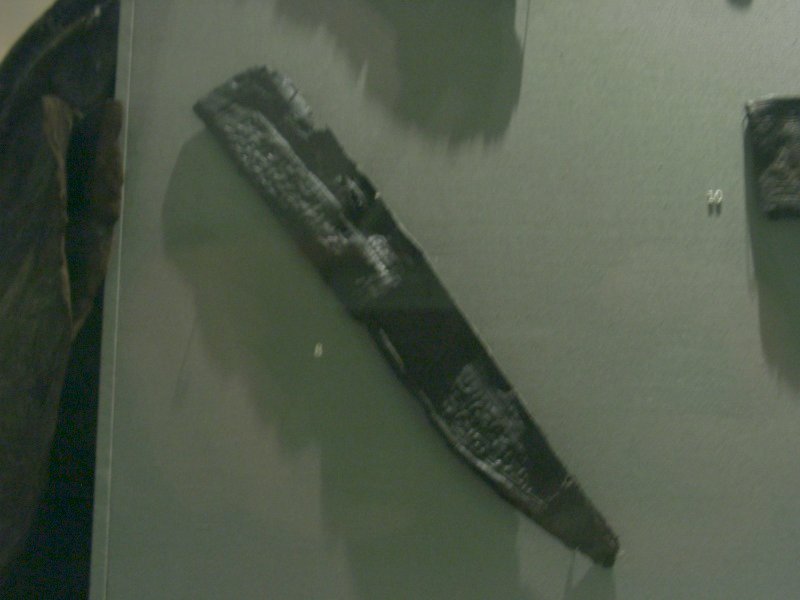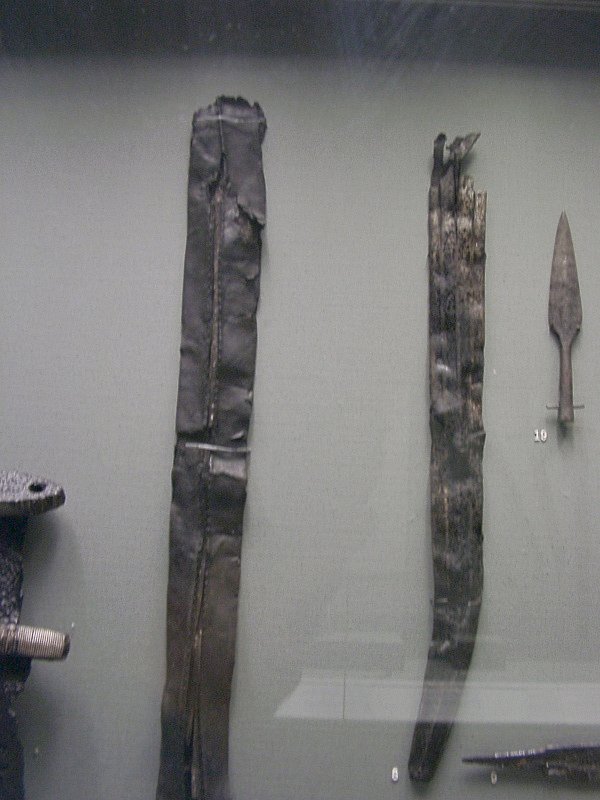| Author |
Message |
|
Jeroen Zuiderwijk
Industry Professional
|
 Posted: Fri 16 Jun, 2006 8:54 am Post subject: Exceptionally well preserved seax scabbard! Posted: Fri 16 Jun, 2006 8:54 am Post subject: Exceptionally well preserved seax scabbard! |
 |
|
I've just got a bundle of publications, which includes a publication of two sax scabbards found in the north of the Netherlands. The first is so perfectly preserved, that it makes an ideal example to be reproduced. The article is called "Twee saxscheden uit Noord-Nederland" by Jaap Ypey (originally from "Groningse volksalmanak" 1978-1979), and can be ordered here (along with many other excellent articles about early medieval and Viking period swords and seaxes by J. Ypey): [url]http://www.antiquariaten.nl/westingpayne/indexnl.html [/url]
The text is in Dutch. I can translate it, but it will be a few weeks before I can spend the time on it. There's a second scabbard featured in the article, which a bit less complete but still complete enough to make a reconstruction off. I'll only post the first here, which is dated to the 6th-7th century. The scabbard is around 35cm long, non-folded width is 17cm and the leather is 0.25-0.3mm thick. The sax (reproduction) shown with it is based on a separate find. It's a very interesting reproduction though, which is a typical example of a Dutch seax with a silver inlayed braided pattern on the blade.
 Attachment: 156.07 KB Attachment: 156.07 KB

 Attachment: 190.98 KB Attachment: 190.98 KB
[ Download ]
 Attachment: 294.09 KB Attachment: 294.09 KB
[ Download ]
 Attachment: 189.07 KB Attachment: 189.07 KB
[ Download ]
 Attachment: 149.37 KB Attachment: 149.37 KB
[ Download ]
|
|
   |
 |
|
David Martin
Location: Southeastern Pennsylvania Joined: 11 Apr 2005
Posts: 165
|
 Posted: Fri 16 Jun, 2006 10:08 am Post subject: Posted: Fri 16 Jun, 2006 10:08 am Post subject: |
 |
|
That is a beautiful sax. What an amazing find! Thank you very much for posting these photos.
I'd love to see more detail of the blade. It look like there is an interesting pattern along the spine.
"When war-gods meet to match their might,
who can tell the bravest born?
Many a hero never made a hole
in another man's breast."
- Sigurd, The Lay of Fafnir
|
|
  |
 |
Nathan Robinson
myArmoury Admin


|
|
    |
 |
|
C.L. Miller
|
 Posted: Fri 16 Jun, 2006 6:19 pm Post subject: Posted: Fri 16 Jun, 2006 6:19 pm Post subject: |
 |
|
| Nathan Robinson wrote: | | I wanted to comment to say that I'm extremely interested in a translation of this text. Thank you for this information! |
I'd like to second that. Your posts are always fascinating Jeroen, and the frequency with which you unearth discoveries such as this one is astounding. I'll be eagerly awaiting your translation!
|
|
  |
 |
|
Joe Fults
|
 Posted: Fri 16 Jun, 2006 9:06 pm Post subject: Posted: Fri 16 Jun, 2006 9:06 pm Post subject: |
 |
|
Now that's something I don't see every day.
"The goal shouldn’t be to avoid being evil; it should be to actively do good." - Danah Boyd
|
|
  |
 |
Jim Adelsen
Industry Professional

|
 Posted: Sat 17 Jun, 2006 7:10 am Post subject: Posted: Sat 17 Jun, 2006 7:10 am Post subject: |
 |
|
Great post! I look very forward to the translation also. Thanks.
www.viking-shield.com
|
|
   |
 |
Steve Grisetti

|
 Posted: Sat 17 Jun, 2006 7:48 am Post subject: Posted: Sat 17 Jun, 2006 7:48 am Post subject: |
 |
|
This looks like a fabulous find. I also would like to see the translation, when you can get to it, Jeroen. Thanks!
"...dismount thy tuck, be yare in thy preparation, for thy assailant is quick, skilful, and deadly."
- Sir Toby Belch
|
|
  |
 |
|
Jeroen Zuiderwijk
Industry Professional
|
 Posted: Sat 17 Jun, 2006 11:49 am Post subject: Posted: Sat 17 Jun, 2006 11:49 am Post subject: |
 |
|
Alrighty, I did manage to find some time, so I translated part of the text. There's a few pages more, but that will have to wait until after my holiday:
Jaap Ypey
Two sax scabbards from North-Netherlands
In 1974 the writer of this article was brought a leather scabbard by drs. J. N. Lanting, which came to light by a reorganization of the finds depot of the Biological-Archeological Institution (in the following shortened as B.A.I.) in Groningen. The piece didn't have an inventory number and searching in the inventory books and exchange of letters also didn't shed anly light. There was a piece of wood between the folded leather, which itself gave the impression that it has been in the depot for decades. The leather of the scabbard was so well-preserved and even reasonably flexible, that it's likely that it's found in a dung heap in a terp (= artifically heightened settlement to cope with the frequent flooding). At the decorated front side, the surface at some places has disappeared and is in general somewhat scaly. By the restorers H.F. Wijnman from the National Institution for Archeological Excavations (Rijksdienst voor het Oudheidkundig Bodemonderzoek, in the following shortened as R.O.B.) and A. Lagerwey from the department of archeology of the Historical Museum of Amsterdam, the piece was treated as much as possible to protect it from further decay. In a bath of diluted phosphoric acid, the ironsalts were removed. The wet piece was then coated in ricinus oil and then the water removed using the alcohol-ether-method. Due to the treatment, there was a slight amount of shrinkage. Before the treatment, the scabbard was measured by the writer and drawn (fig. 1). The length is 35cm; the largest open folded with is 17cm. The scabbard with would have been around 8cm, with a spine thickness of around 1.5cm. The leather was 0.25-0.3cm thick. At the open end the scabbard edge was originally riveted (now loose) with 7 x 3 bronze rivets with round heads. Originally there were probably 8 x 3 rivets. The shaftlength varied from 0.4-0.5cm. The two layers of leather there were compressed to around 0.5cm. The rivet heads have a diameter of around 0.4cm and a height of around 0.15c; the shafts a diameter of 0.2/0.25cm (fig. 3 top). Around 2cm from the edge there is a row of narrow slits, around 0.2-0.3cm wide. Each slit at the surface splits in two slits, which are roughly perpendicular to eachother, and make an angle of 45 degrees with the surface, so a zigzag line appears. Through this the thread was pulled to close the cutting edge side of the scabbard (fig. 1 right). It can be assumed that plant-based thread - linnen - was used, which decayed under the circumstances that preserved the leather. The backside (pl. 2 right) clearly shows the traces of wear between the stitching slits, where the leater was pulled down, the leather could bulge up. With the reconstruction, the same pattern appeared.
Fig. 1 Sax scabbard from the B.A.I. Groningen. Found at unknown location.
Fig. 2 Sax scabbard from the B.A.I. Groningen. Schematics of the decoration of the three long decorated sections.
Fig. 3 Sax scabbard from the B.A.I. Groningen. Top: reconstructed cross-section of the scabbard with wooden inner scabbard and blade. Bottom: the decoration on the bands and the type of stamp for the hammered in transverse lines.
On the location where the edge of the widest part of the scabbard narrows to the scabbard point, the line of the stitching holes runs straight for some more distance and is then cut off. Along the diagonal edge to the point cuts for the thread are visible. At the tip there is even a double row. It's clear that the scabbard was once larger, but was cut down to a smaller size. This also shows at the decoration, which is cut down there diagonally. At the widest part of the scabbard there are at two locations double slits parallel to the edge. Through these narrow bands must have run to hang the scabbard from the belt. The funtion of the square hole at the top side of the scabbard edge is unclear. There are no traces of there having been a metal fitting or button. The transition of the spine to the facets of the scabbard can be seen due to traces of wear. Parallel to the topside and around 4 to 6 cm removed from that, there are also wear markes, and a bulging in between. From this it seems that the blade of the scabbard, at the transition to the hilt must have had an increas in thickness (pl. 1 and 2 right). This makes it possible to derive the length of the blade. The distance from the iron band, which gives the increase in thickness, to the point is around 29cm, and between the stitchings around 28cm, so that the blade couldn't have been any longer. Taking into account the wooden inner scabbard, the scabbard must have had a width of around 4.5cm and a thickness at the spine of 0.5 to 0.7cm (fig. 3 above). This points to a classification of the "Breitsaxen", which according to Bohner with virtually no exception belong to his Stufe IV, which means the 7th century. The reverse side of the scabbard is not decorated. The front side shows at the top edge three narrow horizontal facetsm the top two around 5.3cm x 1.2cm and the third faced 5.3cm x 0.8cm in size. In the first and third facet a 'snake' with braided body; in the second facet a braided pattern without animal head. Then follow three large rectangular facets: 4.5 x 9.3cm; 4.5/4.2 x 10.1 cm and 4.2 x now 8.8cm. The last facet is secundary cut off diagonally and would probably originally also have been 9 to 10cm in length. The surroundings of the decorations were pressed with a V-punch. On the braided patters transverse lines are applied, in which three deepened points can be seen. These are punched in (fig. 3 bottom). The first large facet is filled with a single 'snake'with a braided body and a head at both ends (fig. 2:1). On the schematic drawing the repeating patterns are shown. The second faced is filled with a braided patern existing of 4 bands with no ends (fig. 2:2). The third faced shows a braided pattern existing of a large number of short 'snakes', each with a head (fig. 2.3). The length of the last facet may be taken at around 9.5cm. Next to be taken into account should be a long triangular facet for the scabbad point, probably around 10cm in lenght. The scabbard would then orinally have had a length of over 45cm. The accompanying sax blade could have had a length of 38cm. This also belongs to the group of "Breitsaxen". For verification of the observed details the writer made a copy of the scabbard and accompanying sax (pl. 1-3). The latter was made after an example from grave 233 from the Frankish gravefield in Rhenen, which had practically all the required measurements. This blade also has an iron ring at the transition from blade to hilt. The Rhenen example has an incized decoration on both sides of the blade. From this no conclusions can be made for the decoration on the 'Groningen' blade (fig. 4).
From the by the scabbard determined measurements, the sax from the B.I.A. could be placed in the 7th century. The decoration on the scabbard is also just as important to determine its age. The braided pattern is also found on inlayed iron buckle plates and mountings. On examples from Beerlegem (Belgium) both facets with single braided patterns (grave 107:1) and braided patterns with animalheads (grave 123:19) occur, dated to the first halve of the 7th century.
|
|
   |
 |
|
Jeremy V. Krause
|
 Posted: Sat 17 Jun, 2006 2:57 pm Post subject: Posted: Sat 17 Jun, 2006 2:57 pm Post subject: |
 |
|
Thanks Jeroen for this article and for the translation,
That is really a beautiful reconstruction.
Jeremy
|
|
  |
 |
|
Fabrice Cognot
Industry Professional
|
 Posted: Sat 17 Jun, 2006 6:16 pm Post subject: Posted: Sat 17 Jun, 2006 6:16 pm Post subject: |
 |
|
Thanks Jeroen !
There's something I don't quite get (probably because of the late hour at which I'm reading this stuff) : what is the fig. 3 supposed to depict, exactly ?
Heh. Jaap Ypey....remember the old man who played with your bronze swords on the Friday morning in Dijon (the one who accompanied Stefan Wirth) ? He told me funny stuff about Jaap Ypey, actually. Most remarkable is the way Ipey arrived at their lab in the 60s, with a pattern-welded sword protruding from his backpack 
Thanks again anyway. If you happen to have good hints to migration era axes (typologies, etc), I'd be more than interested
Fab
PhD in medieval archeology.
HEMAC member
De Taille et d'Estoc director
Maker of high quality historical-inspired pieces.
|
|
   |
 |
Nathan Robinson
myArmoury Admin


|
|
    |
 |
Steve Grisetti

|
 Posted: Sat 17 Jun, 2006 8:12 pm Post subject: Posted: Sat 17 Jun, 2006 8:12 pm Post subject: |
 |
|
Thanks, Jeroen!
"...dismount thy tuck, be yare in thy preparation, for thy assailant is quick, skilful, and deadly."
- Sir Toby Belch
|
|
  |
 |
|
Jeroen Zuiderwijk
Industry Professional
|
 Posted: Sat 17 Jun, 2006 11:45 pm Post subject: Posted: Sat 17 Jun, 2006 11:45 pm Post subject: |
 |
|
| Fabrice Cognot wrote: | Thanks Jeroen !
There's something I don't quite get (probably because of the late hour at which I'm reading this stuff) : what is the fig. 3 supposed to depict, exactly ? |
"Fig. 3 Sax scabbard from the B.A.I. Groningen. Top: reconstructed cross-section of the scabbard with wooden inner scabbard and blade. Bottom: the decoration on the bands and the type of stamp for the hammered in transverse lines. " 
| Quote: | Heh. Jaap Ypey....remember the old man who played with your bronze swords on the Friday morning in Dijon (the one who accompanied Stefan Wirth) ? He told me funny stuff about Jaap Ypey, actually. Most remarkable is the way Ipey arrived at their lab in the 60s, with a pattern-welded sword protruding from his backpack  |
Cool!  Now pattern-welded swords are fairly common, but back then that must have been quite a sight Now pattern-welded swords are fairly common, but back then that must have been quite a sight  Do you know by any chance of he's still around? I've only recently come to know him since I started looking into early medieval material. Do you know by any chance of he's still around? I've only recently come to know him since I started looking into early medieval material.
| Quote: | | hanks again anyway. If you happen to have good hints to migration era axes (typologies, etc), I'd be more than interested |
I'll keep that in mind. My current focus is on seaxes and swords, so I haven't delved into axes yet.
|
|
   |
 |
|
Fabrice Cognot
Industry Professional
|
|
   |
 |
|
Jeroen Zuiderwijk
Industry Professional
|
 Posted: Mon 03 Jul, 2006 1:51 am Post subject: Posted: Mon 03 Jul, 2006 1:51 am Post subject: |
 |
|
Well, guess what happened. I only just found that article, then I walked almost literally against several more examples. Last week I was in the National Museum in Dublin in Ireland, and to my surprize there were a number of excellent preserved seax scabbards! Here's the first.
 Attachment: 102.49 KB Attachment: 102.49 KB

|
|
   |
 |
|
Jeroen Zuiderwijk
Industry Professional
|
 Posted: Mon 03 Jul, 2006 1:52 am Post subject: Posted: Mon 03 Jul, 2006 1:52 am Post subject: |
 |
|
And another. Sorry about the poor quality of the photos, the lighting wasn't optimal.
 Attachment: 46.45 KB Attachment: 46.45 KB

|
|
   |
 |
|
Jeroen Zuiderwijk
Industry Professional
|
 Posted: Mon 03 Jul, 2006 1:53 am Post subject: Posted: Mon 03 Jul, 2006 1:53 am Post subject: |
 |
|
And another. There were two more, but those were just fragments.
 Attachment: 73.14 KB Attachment: 73.14 KB

|
|
   |
 |
|
Jeroen Zuiderwijk
Industry Professional
|
 Posted: Mon 03 Jul, 2006 1:55 am Post subject: Posted: Mon 03 Jul, 2006 1:55 am Post subject: |
 |
|
And something else that was interesting: two Viking sword scabbards!
 Attachment: 77.5 KB Attachment: 77.5 KB

|
|
   |
 |
|
Fabrice Cognot
Industry Professional
|
|
   |
 |
|
Russ Ellis
Industry Professional
|
 Posted: Mon 03 Jul, 2006 7:00 am Post subject: Posted: Mon 03 Jul, 2006 7:00 am Post subject: |
 |
|
Well, all I can do is add my thanks to the general applause! A great find, and thank so much for the pictures!
TRITONWORKS Custom Scabbards
|
|
  |
 |
|
|

